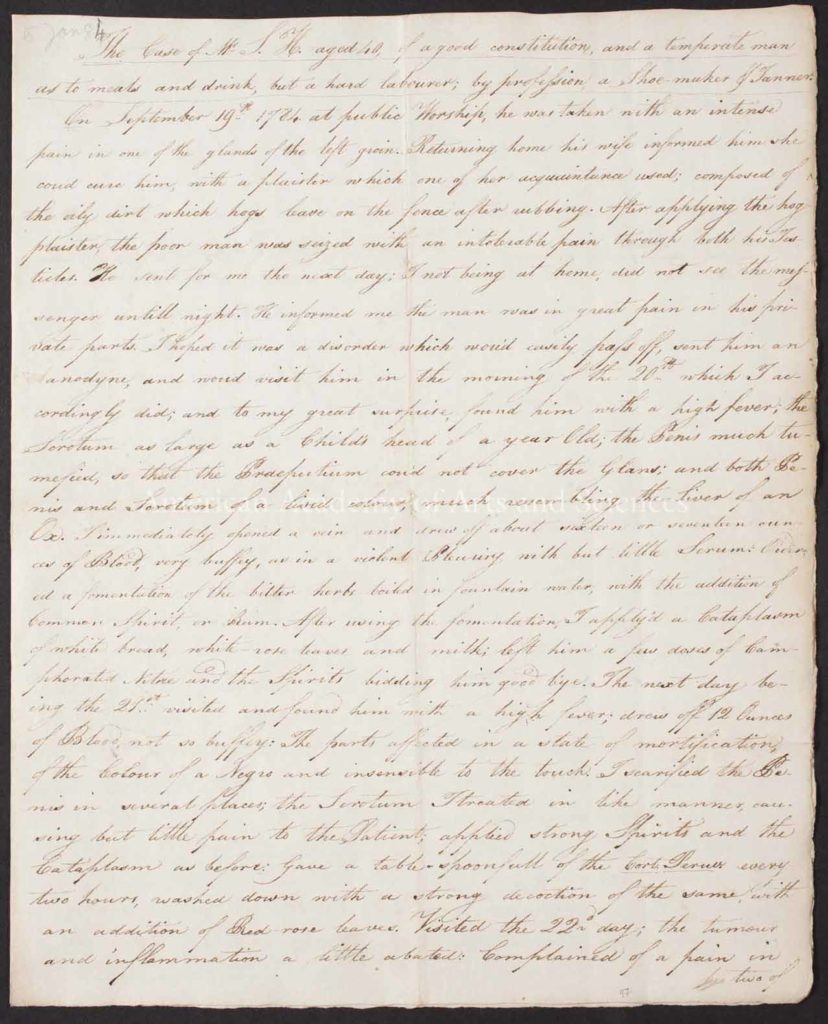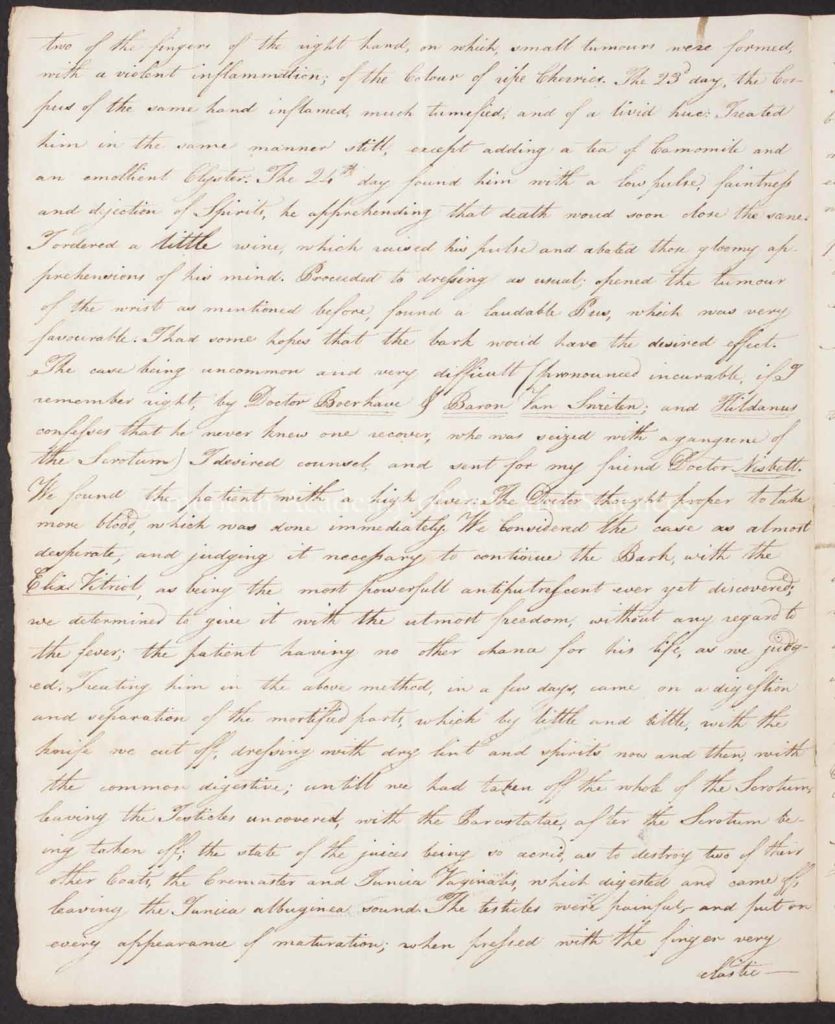Fournier gangrene
Description
Fournier gangrene – a fulminant polymicrobial necrotizing fasciitis affecting the perineal or genital regions. Patients typically present with swelling, pain, crepitus, and fever.
CT imaging can determine the extent of disease prior to surgery, and refine the potential source of the infection. Scans can demonstrate asymmetric fascial thickening, soft tissue oedema, fluid collections, and gas (90%)
Fournier stressed that hallmarks of the gangrene were both the fulminant course and the unidentified source. However contemporary cases can generally be attributed to local trauma or infection from genitourinary, anorectal, perineal or genital skin sources. No identifiable cause is only found in 8-10% of cases
Key co-morbidities have been identified since the original description as idiopathic. Diabetes mellitus is by far the most common (20-70% cases), followed by chronic alcoholism, malignancy and other immunosuppressed states.
History of Fournier gangrene
1764 – H Baurienne published the case of a 45 year old army butcher suffering from secondary infection after having suffering pelvic and perineal injuries from the horns of a bull
Le nomme Pierre Jacque, garcon boucher de l’armee, age de quarante-cinq ans, achetant un boeuf a Francfort, & voulant I’examiner, recut de cet animal des coups de cornes, qui lui firent deux plaies contuses, d’ont l’une s’etendoit depuis la partie inferieure des os pubis, du cote droit, jusqu’au perine, du mdme cote; & I’autre etoit situee a la partie superieure interne de la cuisse gauche; le blesse tomba a la suite des coups, avec perte de connaissance, & fut transporte chez lui.Baurienne
Pierre Jacque, a butcher in the army, aged forty-five, buying a bull in Frankfurt, was wishing to examine it, and received from this animal some blows of horns, which gave him two contused wounds, one stretched from the lower part of the pubic bones, on the right side, to the perineum, on the same side; the other was situated at the upper internal part of the left thigh…Baurienne
1784 – Leverett Hubbard (1725-1794) was a physician practicing in New Haven and the first President of the Connecticut Medical Society. He delivered a communication before the Medical Society of New Haven County on the case of Mr. S. H. aged 40 and the successful treatment for “intense pain in his private parts”.
Hubbard original hand-written communication 1784:




1848 – Hebler described a case of a 12 week old infant with erysipelas of the genital region which, on the third day, developed into gangrene of the scrotum and prepuce.
1883 – Alfred Jean Fournier (1832-1914) provided the first clinical descriptions of idiopathic, rapidly progressive necrotizing perineal gangrene in 5 male patients characterized by the absence of any predetermined cause, of sudden onset, with rapid progression, and excessive morbidity
En tout cas, dès à présent, ce que je puis affirmer, au nom de la clinique, c’est qu’à coup sûr il existe une gangrène de la verge différente des autres gangrenes du même organe, et différente à divers titres
- Par l’absence de cause actuellement déterminable ;
- Par des symptômes très particuliers, dont les principaux sont : un début soudain et fulminant ; une propagation étonnamment rapide ; une propagation toujours considérable ; la coexistence fréquente de purpura ; et, en bref, une gravité excessive.
C’est à ce type de gangrène qu’il n’est pas exagéré de donner le nom de gangrène fulminante, et c’est à sa description que je me propose de consacrer une prochaine réunion.
In any case and for the present, I want to state in the name of our Clinic, that there exists a different gangrene of the penis from the other types involving the same organ, and different in these respects:
1. By the absence of any predetermined cause.
2. By special symptoms of which the principal ones follow: A gangrenous and sudden beginning; astonishingly rapid extension; always considerable extension; the frequent coexistence of purple discolouration; and finally an excessive morbidity.
It is this type of gangrene which, it is no exaggeration to say, should be given the name, fulminant, and it is this description which I propose to dedicate in our next discussion.
Associated Persons
- Alfred Jean Fournier (1832-1914)
- Leverett Hubbard (1725-1794)
Alternative names
- Fournier’s gangrene
- Gangrène foudroyante de la verge
Controversies
- Early descriptions of scrotal gangrene have been attributed to many authors however, most of these cases were not idiopathic, nor were they fulminant.
- Of note, from reviewing the literature. Baurienne described a 45 year old male (not 5 year old boy);
References
Original articles
- Baurienne H. Sur une plaie contuse qui s’est terminée par le sphacèle de le scrotum. Journal de médecine, chirurgie, pharmacie, etc. 1764; 20: 251-256.
- Communications to the Academy. 1780-1810. The Case of Mr. S. H. American Academy of Arts and Sciences series. 2012: p19-20
- Hebler. Brand des Hodensackes und volständiger Wiedersatzung. Medicinische Zeitung 1848; 4: 188-9.
- Fournier JA. Jean-Alfred Fournier 1832-1914. Gangrène foudroyante de la verge (overwhelming gangrene). Semaine médicale. 1883;2: 345-347. [Translated: Dis Colon Rectum. 1988;31(12):984-988.]
Review articles
- Levinson A. Gangrene of the scrotum in Infants and on children. Am J Dis Child. 1931; 41(5):1123-1127.
- Toodayan N. Jean Alfred Fournier (1832-1914): His contributions to dermatology. Our Dermatol Online; 2015.4-32
- Di Serafino M, Gullotto C, Gregorini C, Nocentini C. A clinical case of Fournier’s gangrene: imaging ultrasound. J Ultrasound. 2014 Jul 1;17(4):303-6.
- Morpurgo E, Galandiuk S. Fournier’s gangrene. Surg Clin North Am. 2002 Dec;82(6):1213-24.
- Levenson RB, Singh AK, Novelline RA. Fournier gangrene: role of imaging. Radiographics. 2008 Mar-Apr;28(2):519-28
eponymictionary
the names behind the name
Bsc (Hons) MD from the University of Western Australia. Born and raised in Perth, Western Australia and currently working as a Urology Registrar within WA Health. Has a keen interest in health, fitness and water based sports.
BA MA (Oxon) MBChB (Edin) FACEM FFSEM. Emergency physician, Sir Charles Gairdner Hospital. Passion for rugby; medical history; medical education; and asynchronous learning #FOAMed evangelist. Co-founder and CTO of Life in the Fast lane | On Call: Principles and Protocol 4e| Eponyms | Books |

